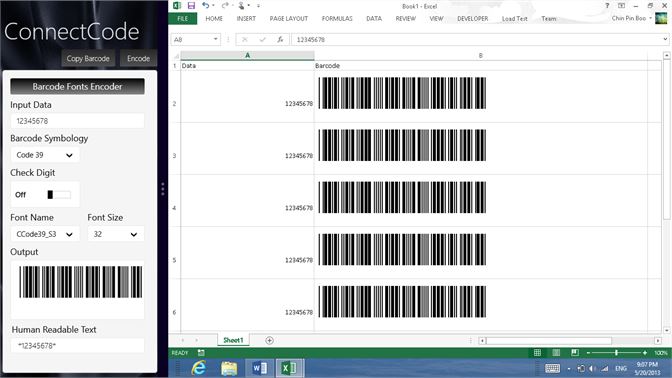Using barcodes in Excel has become way easier, faster and more powerful.
The detailed manual explains all features. This step-by-step tutorial gives a quick demo.
Attempting to do this with Code 128 barcodes will fail. Because I recently had reason to generate Code 128 barcodes, I felt it would be valuable to publish my methodology, which relies on the work of several other people. Follow these steps in order to create your own Code 128 barcode generator in Excel: Step 1. Label the third column “Barcode” and create three records: “987654321”, “ CLEARLY123 “, and “Clearly Inventory is easy!” Yes, they look almost the same, but this is the actual information that we’ll be encoding in the barcode itself. Those asterisks are CRITICAL. Create a link between a cell and the barcode: Open the property dialog of Excel as described above. Now activate the barcode object by clicking onto it once. The property dialog will now display all the properties of the barcode object. Have a look for the property named 'LinkedCell'.
A short description of how to add a barcode to an Excel document and link the barcode with a cells content.
First launch Excel and create a new document or open an already existing document.
Make sure that you have configured your Excel in such a way that the 'Developer' tab appears. To do this, go to in the Excel Options by clicking the 'File' tab. This switches to the Backstage view. Then click on 'Options' in the tab group on the left:
Under 'Customize Ribbon', enable the 'Developer' option on the main tabs, then close the options window.


Now you can embed the ActiveBarcode control element into your Document. Now select the 'Developer' tab. Click on the button 'Insert' from the range of 'ActiveX Controls' and then select 'More controls' there.
A dialog box appears on the screen:
Select 'ActiveBarcode' now and click 'Ok'. Now a barcode will be created inside your document. This will be a standard barcode of EAN-128 type. This is the default type. You can change this to any barcode type supported by ActiveBarcode: QR Code, GS1/EAN-128, Data Matrix, GTIN/EAN-13, Code 39, GS1-Data Matrix, Code 128, PDF417, DUN-14, EAN-8, EAN-14, EAN-18, ISBN, ITF-14, NVE, PZN8, SCC-14, SSCC-18, ...
Now you can modify this barcode. You can change the type, text, colors etc. For this click inside the barcode with the right mouse button. A pop up menu will open:
Select 'ActiveBarcode-Object' and then 'Properties...'. The property dialog of ActiveBarcode will open. Here you can modify the barcode as you like.
Alternatively you can use the property dialog of Excel. For this use the following button named 'Properties' of the 'Controls' range:
Create a link between a cell and the barcode: Open the property dialog of Excel as described above. Now activate the barcode object by clicking onto it once. The property dialog will now display all the properties of the barcode object. Have a look for the property named 'LinkedCell'. This allows a link between a cell and the barcode:
Enter the cell's name for the link into this property. That's it!
If you want to create a barcode that encodes data from several cells, you must first merge these cells into an helping cell. Then connect this combined cell with the barcode object.
In the following example, the contents of cells B3 and B4 are combined in cell B6. Cell B6 is linked to the barcode object.

How to Generate 2D Barcodes in Excel
Generating 2D barcodes from fonts in Microsoft Excel is more complicated than generating standard linear barcodes from fonts because Excel does not recognize line breaks or carriage returns when the data is being encoded in Excel. This results in a barcode display that does not stack the individual lines of encoded text. Instead, these blocks are laid out horizontally to form a rectangle rather than a square. This is not a readable 2D barcode. While the IDAutomation Barcode Add-In may not be directly compatible with Excel, there are a few alternatives that we can explore.
ActiveX Barcode Controls

- Data Matrix (ECC200, also conforms to UID label marking standards)
- PDF417
- MaxiCode
- Aztec
